




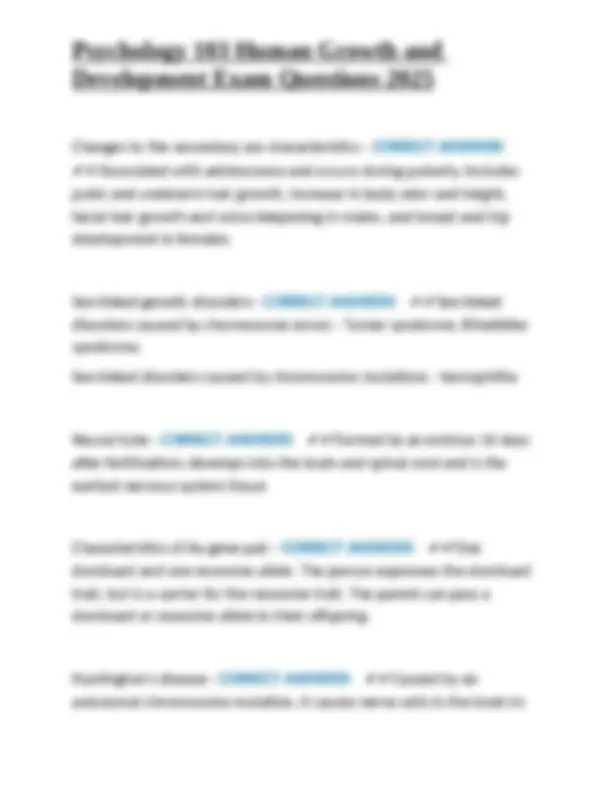










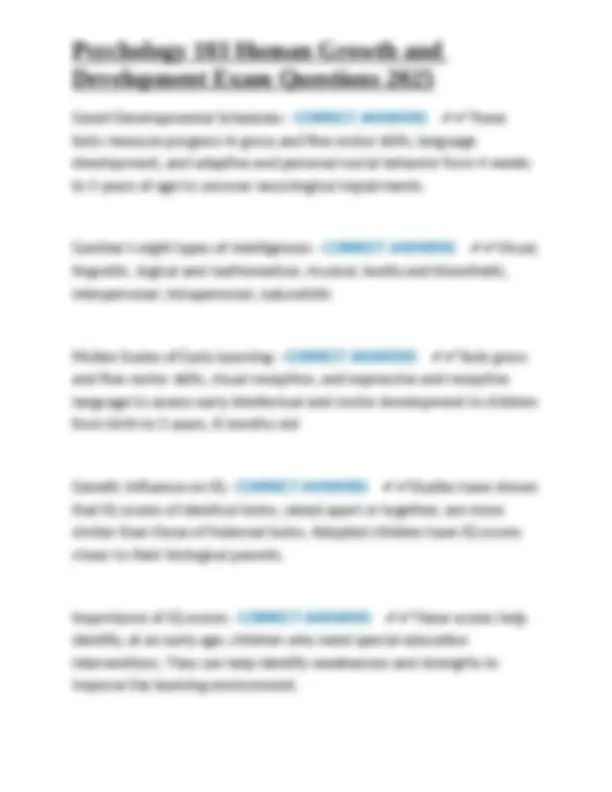










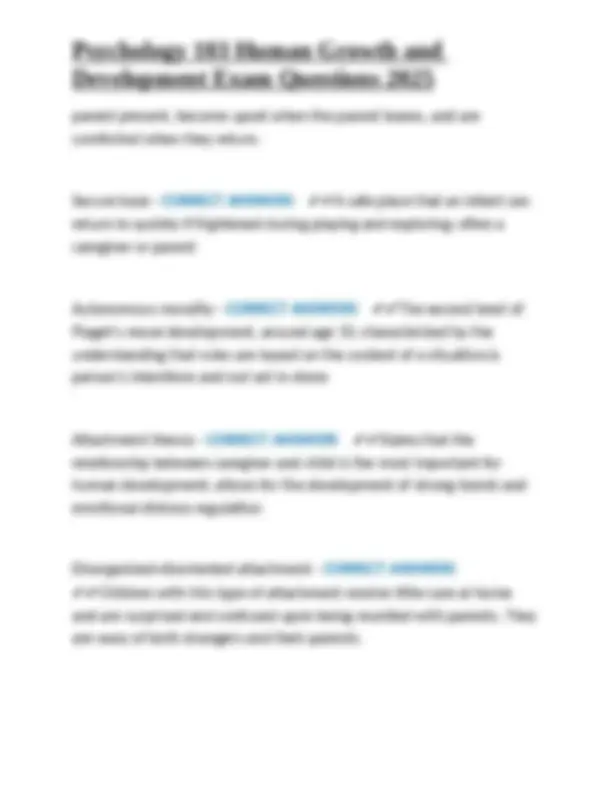

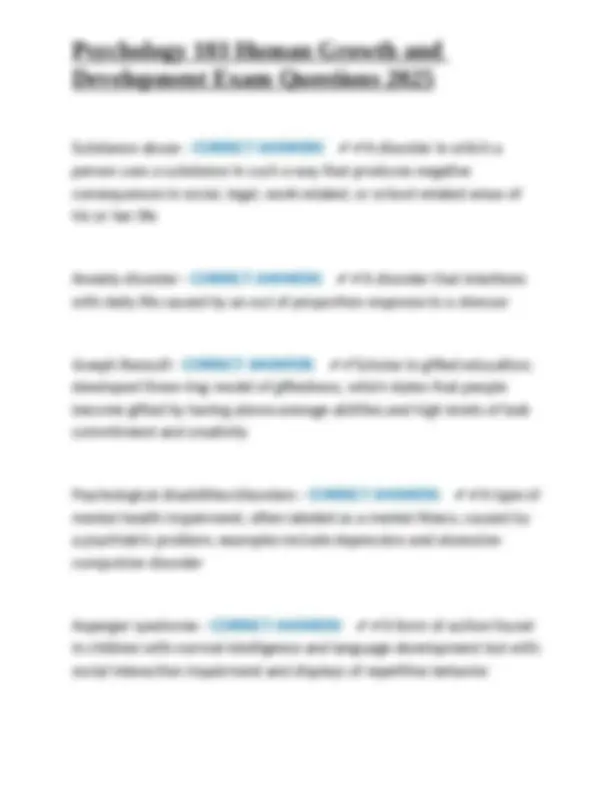
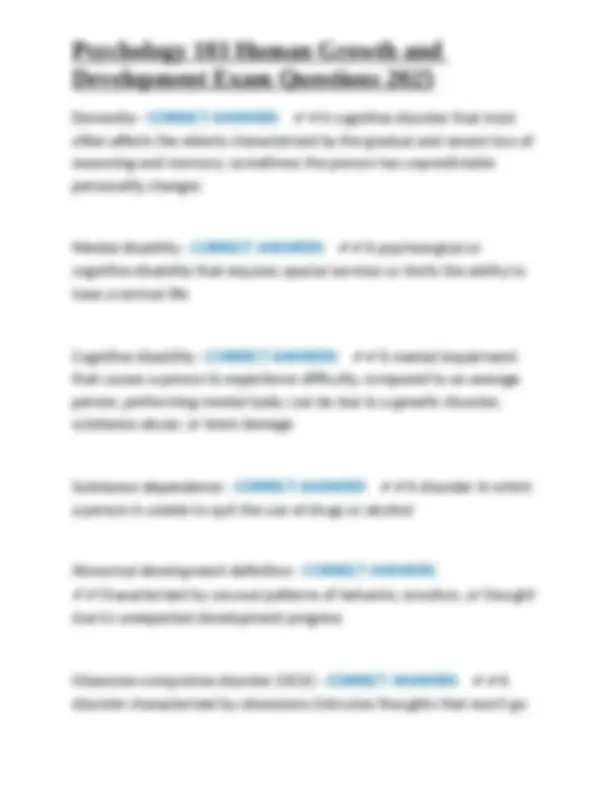





Study with the several resources on Docsity

Earn points by helping other students or get them with a premium plan


Prepare for your exams
Study with the several resources on Docsity

Earn points to download
Earn points by helping other students or get them with a premium plan
Community
Ask the community for help and clear up your study doubts
Discover the best universities in your country according to Docsity users
Free resources
Download our free guides on studying techniques, anxiety management strategies, and thesis advice from Docsity tutors
Psychology 103 Human Growth and Development Exam Questions 2025
Typology: Exams
1 / 41

This page cannot be seen from the preview
Don't miss anything!


































An Independent Variable - CORRECT ANSWERS ✔✔The variable that is CHANGED during a research experiment Autonomy versus Shame and Doubt - CORRECT ANSWERS ✔✔Erikson's belief of the conflict in children ages 1-3. They are exploring their surroundings, to see if they are able to handle new findings. Longitudinal Study - CORRECT ANSWERS ✔✔Longitudinal research projects examine one individual or one group over an extended period of time. Random Sample - CORRECT ANSWERS ✔✔A random sample is when every participant in a research study has an equal likelihood of being selected to participate in the study. This is part of research design. Albert Bandura's social learning theory - CORRECT ANSWERS ✔✔This theory revolves around the reciprocal causation model highlighting the importance of the interactions between behavioral elements, personal factors and the environment. Identity versus Role-Confusion - CORRECT ANSWERS ✔✔Erik Erikson's 5th stage of development. Occurs in adolescence, where a teenager
struggles to find an identity, and does so by making new relationships with other adults and friends. Validity in Research - CORRECT ANSWERS ✔✔The term used to assess if a research study measures what it proposes to measure Spontaneous recovery - CORRECT ANSWERS ✔✔Spontaneous recovery is the unexpected recurrence of a conditioned response after that behavior has shown extinction. It is normally short lived. Erik Erikson's theory of identity formation - CORRECT ANSWERS ✔✔He believed humans pass through eight stages of psychosocial development. Each stage is characterized by two opposing forces. Psychoanalytic theory - CORRECT ANSWERS ✔✔Psychoanalytic theory looks at the role of the unconscious as a motivator behind behaviors. Gender schema theory - CORRECT ANSWERS ✔✔This theory states children form their own concept of gender roles by observing typical characteristics and behaviors of those around them, including teachers, parents, and society at large.
consequence. A negative punishment is REMOVING something desirable as a consequence. Genital Stage - CORRECT ANSWERS ✔✔Freud's final developmental stage of an individual in which biological impulses battle against moral obligations. This stage starts in the teenage years and lasts through adulthood. Case Study - CORRECT ANSWERS ✔✔A case study is a research project examining the data from one individual or one specific event. Primary Data Collection - CORRECT ANSWERS ✔✔When existing information is unusable, primary data collection procures data for an area of research. Surveys, observations and experimental designs are all forms of primary data collection. Bronfenbrenner's Ecological Systems Theory - CORRECT ANSWERS ✔✔A theory of development that looks at the effect of the environment (the microsystem, the mesosystem, the exosystem, the macrosystem, and the chronosystem) on an individual. Freud's versus Erikson's Developmental Theories - CORRECT ANSWERS ✔✔Freud's theory is based on PYSCHOSEXUAL stages, the power of
biological drives. Erikson's theory is based on PSYCHOSOCIAL stages, the interaction between society and the environment. Trust versus Mistrust - CORRECT ANSWERS ✔✔Erikson's first stage of infancy. The major conflict at this point of development is whether a person can be trusted to provide care. Vicarious reinforcement - CORRECT ANSWERS ✔✔Vicarious reinforcement has 2 major components:
Y-linked traits - CORRECT ANSWERS ✔✔Traits that are found on the Y- chromosome. Since only men have Y-chromosomes, only they will inherit these traits. Prenatal brain development in the second trimester - CORRECT ANSWERS ✔✔Month 4 - the fetus experiences its senses; Month 5 - the fetus starts to control reactions to senses and movement; Month 6 - the cerebral cortex splits into two hemispheres Eating disorders - CORRECT ANSWERS ✔✔People with these have severe disturbances in their eating habits. Family studies have shown that there may be a genetic cause for eating disorders and a link with depression, anxiety, and OCD. Reflex - CORRECT ANSWERS ✔✔An involuntary action or response to a stimulus. Examples include sneezing, coughing, and blinking. Polygenic inheritance - CORRECT ANSWERS ✔✔When two or more genes control the expression of one trait; a person's height is determined by this
Genetic code - CORRECT ANSWERS ✔✔The set of rules that determines what proteins are made of based on information encoded in genetic material, such as DNA Orthogenetic principle - CORRECT ANSWERS ✔✔States that development proceeds from the simple to the complex Psychopathology - CORRECT ANSWERS ✔✔A deviation from normal mental and behavioral processes that can be attributed to genetic and environmental factors. Schizophrenia is one example of this. Characteristics of AA gene-pair - CORRECT ANSWERS ✔✔Contains two copies of the dominant allele. The dominant trait will be expressed. The parent can only pass a dominant allele to their offspring. Regression towards the mean - CORRECT ANSWERS ✔✔When parents are at the extreme high or low end of a trait, this theory suggests that their offspring will be closer to the average for that trait. Cephalocaudal principle - CORRECT ANSWERS ✔✔This principle states that physical development occurs from top to bottom. For example, children gain control of their head before their arms and legs.
break down. It is known as a dominant disorder because only one copy of the mutated gene is required. Three stages of active labor - CORRECT ANSWERS ✔✔First stage - dilation; Second stage - descent and birth; Third stage - delivery of the placenta Autosome - CORRECT ANSWERS ✔✔Any of the first 22 pairs of chromosomes Physical development during middle adulthood - CORRECT ANSWERS ✔✔Occurs between ages 35-65, characterized by physical changes, such as loss of strength, flexibility, and skin elasticity, weight gain, hair thinning, and menopause in women. Antisocial personality disorder - CORRECT ANSWERS ✔✔People with this disorder do not care about the rights, feelings, and safety of others. Research suggests there is a genetic link, though the strength of the link is unknown.
Heritability - CORRECT ANSWERS ✔✔A numerical value between 0 and 1 that measures the amount of variability for some characteristic caused by genetics. A measure of 0 indicates that none of the variation is caused by genetics. Allele - CORRECT ANSWERS ✔✔One part of a gene-pair; you inherit one of these from your mother and one from your father Mutation - CORRECT ANSWERS ✔✔A change in the genetic code, which can occur during mitosis or meiosis, that is permanent and heritable Puberty - CORRECT ANSWERS ✔✔Occurs during adolescence and refers to the process of sexual maturity. It is triggered by gonadotrophins, or sex hormones, by the hypothalamus and pituitary glands. Fetal period of development - CORRECT ANSWERS ✔✔Lasts from 10th week of pregnancy until birth. The baby's height and weight will increase dramatically, and organ systems will grow and develop.
Genetic inheritance - CORRECT ANSWERS ✔✔The passing down of genes from parent to offspring Perinatal environment - CORRECT ANSWERS ✔✔The medical and social environment surrounding the birth of a child Klinefelter syndrome - CORRECT ANSWERS ✔✔A type of sex-linked chromosome error that occurs only in men. Affected men have an extra copy of the X chromosome, which interferes with fertility and sexual development. Schizophrenia - CORRECT ANSWERS ✔✔A disorder in which those affected have severely impaired thinking, emotions, and behaviors. Adoption studies suggest that there is a genetic link, though the gene is unknown. Apgar test - CORRECT ANSWERS ✔✔At 1 and 5 minutes post-birth, it's used to test how the newborn tolerated birth and has adapted to its new environment. It evaluates color, heart rate, reflexes, muscle tone, and respiration. Changes to the primary sex characteristics - CORRECT ANSWERS ✔✔Changes to sexual organs during puberty. The prostate gland,
testes, seminal vesicles, and penis grow in males, and in females, the uterus begins to build a lining and vagina produces discharge. Identical twins - CORRECT ANSWERS ✔✔Formed when a fertilized egg splits into two parts, forming 100% genetically identical embryos, which may or may not share a placenta and embryonic sac; also known as monozygotic twins Meiosis - CORRECT ANSWERS ✔✔Sex cells are produced by this special type of cell division. The original number of chromosomes is halved during this process. Placenta - CORRECT ANSWERS ✔✔A temporary organ joining the mother and fetus through the umbilical cord which provides nutrients and oxygen while removing wastes; harmful substances can pass through this Therapeutic use of sensory deprivation - CORRECT ANSWERS ✔✔Partial sensory deprivation, such as from a float tank, can be used to induce deep relaxation and have a healing effect. Common age-related changes to the sense of smell - CORRECT ANSWERS ✔✔Loss of nerve endings and decreased mucus production
Perceptual grouping - CORRECT ANSWERS ✔✔Perceptual grouping, an important concept to Gestalt theory, says that separate units of perception are formed by visual elements organized into groups. How the sense of touch changes during aging - CORRECT ANSWERS ✔✔Aging can cause reduced sensitivity to pain, temperature, and body position. Negative consequences of sensory deprivation - CORRECT ANSWERS ✔✔Sensory deprivation during important developmental periods can have often permanent effects on a child's well-being, and has been linked to anger, aggression, and depression later in life. Aging-related hearing changes - CORRECT ANSWERS ✔✔The ability to detect sounds, especially high frequency sounds, decreases in both ears due to aging. Understanding speech on top of background noise also becomes difficult. Gestalt theory - CORRECT ANSWERS ✔✔The idea that the individual parts of something are perceived differently than the organized whole. For example, a tree as a whole is perceived differently than the individual parts of the tree.
Newborn sense of smell characteristics - CORRECT ANSWERS ✔✔A newborn can recognize his mother's scent and his mother's breast milk. He can tell the difference between scents within the first week of life, and will prefer pleasant scents. Sensory deprivation - CORRECT ANSWERS ✔✔Sensory deprivation occurs when a person receives little or no sensory (for example. hearing, sight, smell, etc.) input. Sensory threshold - CORRECT ANSWERS ✔✔The level of strength a stimulus must reach to be perceived. There are two types: absolute and differential thresholds. Sensitive Period - CORRECT ANSWERS ✔✔Several overlapping periods of development where a child is sensitive to a particular stimuli. There are five main categories of sensitive periods between birth and age six. Object permanence - CORRECT ANSWERS ✔✔Object permanence is a major milestone that occurs between ages 8-12 months. A child is capable of understanding that even when objects cannot be seen, they still exist.
Short-term memory - CORRECT ANSWERS ✔✔Also known as working memory, short-term memory is used for things like remembering plans for the day. Memories are held here for a short period of time unless they are processed further. Characteristics of crystallized intelligence - CORRECT ANSWERS ✔✔The ability to use previously learned knowledge, skills and experiences. It increases through childhood and adolescence, peaks during young adulthood and can continue to grow into late adulthood. Naive psychology - CORRECT ANSWERS ✔✔In this stage of speech and language development, theorized by Lev Vygotsky, children first begin to use adult words for objects. It occurs between 18 and 24 months. Divided attention - CORRECT ANSWERS ✔✔This occurs when we are paying attention to more than one thing at a time. Zone of proximal development - CORRECT ANSWERS ✔✔Commonly referred to as ZPD, the zone of proximal development are the tasks that children can perform with guidance but cannot yet perform independently.
sensory memory - CORRECT ANSWERS ✔✔This stage of memory lasts a few seconds and involves using our senses to observe our environment. Selective attention - CORRECT ANSWERS ✔✔This occurs when we focus on a single feature while blocking out the rest of our environment. Motor or physical play - CORRECT ANSWERS ✔✔This type of play involves children engaging in physical activity for more than just fun, and is useful for strengthening the body and the brain. Alzheimer's disease - CORRECT ANSWERS ✔✔Alzheimer's is a disease of the brain that causes memory loss, and is the cause of 60-80% of dementia cases. Pretend play - CORRECT ANSWERS ✔✔Pretend play is a type of fantasy play in which children use their imaginations in pretend scenarios. For example, a little girl having a make-believe tea party is engaging in pretend play.